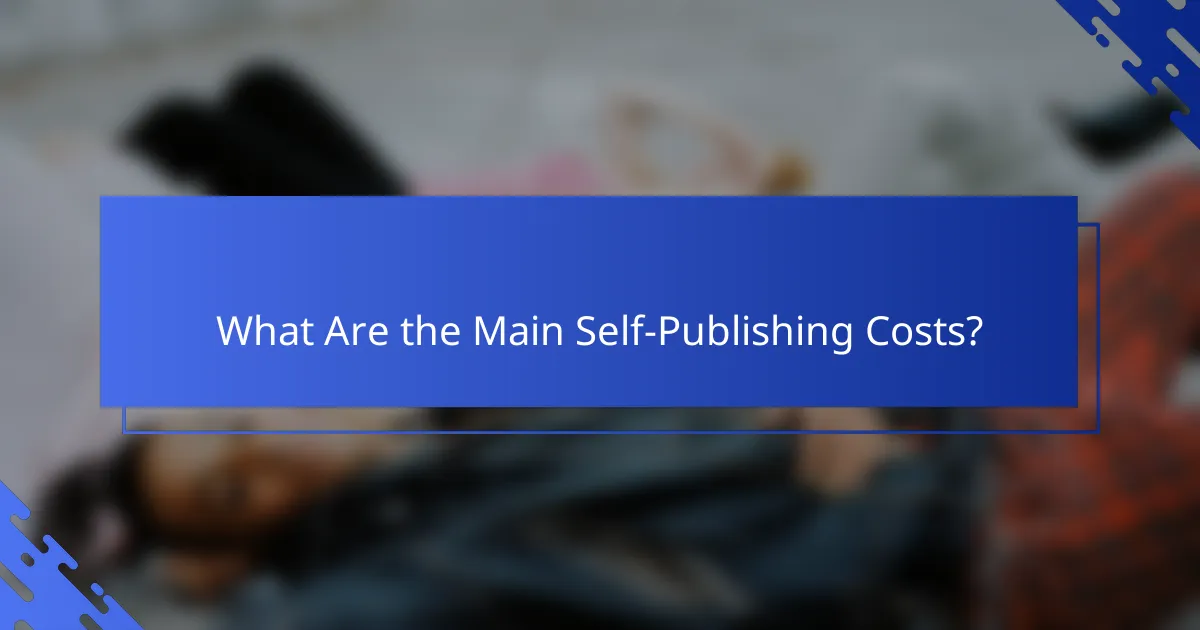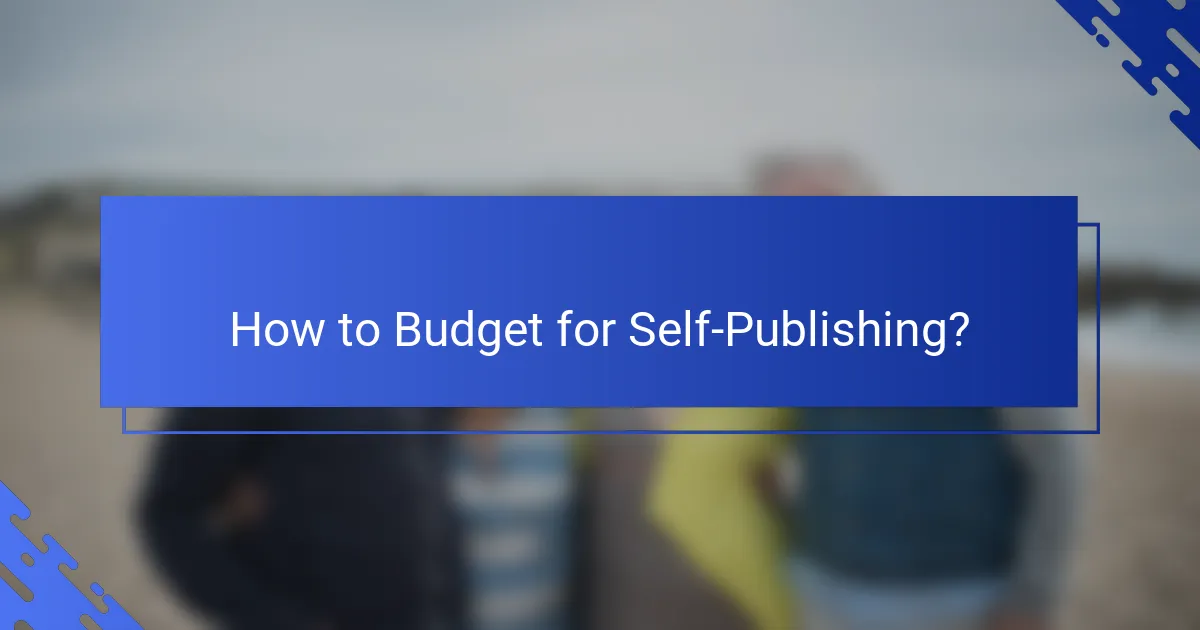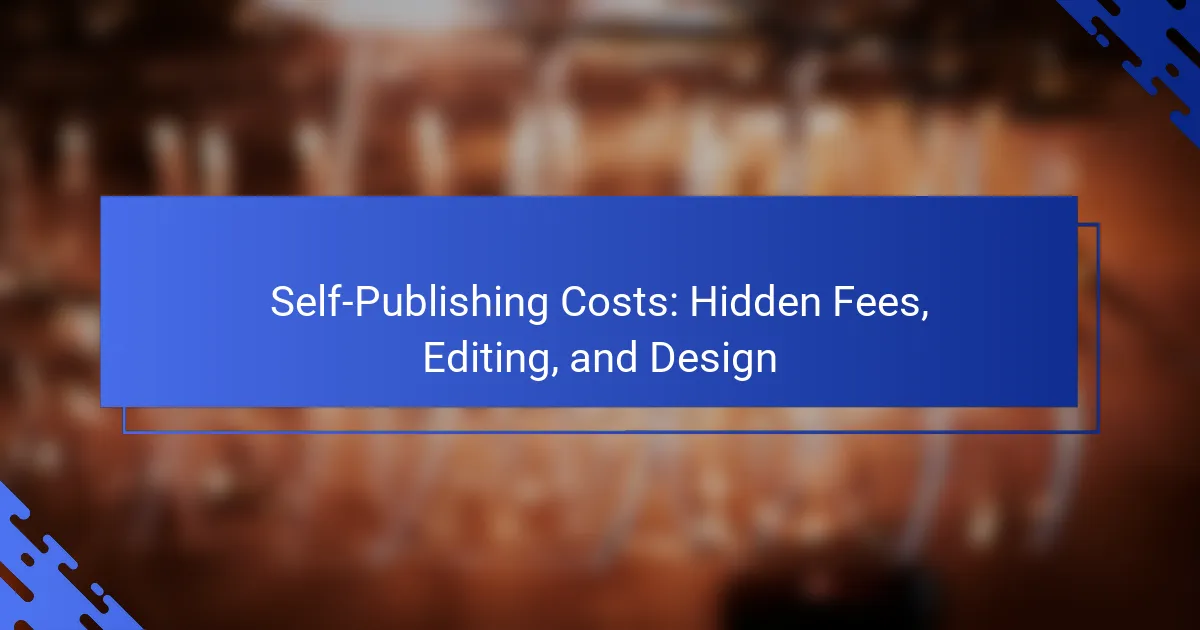Self-publishing can be an exciting journey, but it also comes with a range of costs that authors must navigate. From editing and design to hidden fees and marketing expenses, understanding these financial aspects is essential for a successful publication. By budgeting carefully and being aware of potential hidden charges, authors can ensure they allocate their resources wisely and avoid unexpected financial pitfalls.

What Are the Main Self-Publishing Costs?
Self-publishing involves various costs that can significantly impact your budget. Understanding these expenses, including editing, design, marketing, distribution, and printing, is crucial for successful publication.
Editing fees
Editing fees are essential for ensuring your manuscript is polished and professional. Costs can vary widely, typically ranging from a few hundred to several thousand dollars, depending on the type of editing required—developmental, copyediting, or proofreading.
When budgeting for editing, consider the complexity of your work and the experience level of the editor. It’s advisable to request samples and quotes from multiple editors to find the best fit for your project.
Design costs
Design costs encompass both cover design and interior formatting, which are critical for attracting readers. Professional cover design can range from $300 to over $1,500, while interior formatting might cost between $100 and $500.
Investing in quality design can significantly enhance your book’s marketability. Be sure to review portfolios and seek designers who specialize in your genre for the best results.
Marketing expenses
Marketing expenses are vital for promoting your self-published book and can vary greatly based on your strategy. You might spend anywhere from a few hundred to several thousand dollars on advertising, social media promotions, and book launch events.
Consider allocating a budget for online ads and author platforms. Engaging with your target audience through social media and email marketing can also yield positive results without breaking the bank.
Distribution fees
Distribution fees are incurred when you choose to sell your book through online retailers or print-on-demand services. These fees typically range from 30% to 55% of your book’s retail price, depending on the platform.
It’s essential to compare different distribution options, such as Amazon KDP, IngramSpark, or others, to understand their fee structures and reach. Choose a distributor that aligns with your sales goals and budget.
Printing costs
Printing costs depend on factors like the book’s format (e.g., paperback or hardcover), page count, and print run size. For print-on-demand services, expect costs to be around $3 to $10 per copy, while bulk printing can lower the per-unit cost significantly.
When planning for printing, consider your sales projections and storage capabilities. Balancing quality and cost is key to maximizing your profit margins while meeting reader demand.

What Hidden Fees Should Authors Expect?
Authors should be aware that self-publishing often comes with various hidden fees that can significantly impact their overall costs. These fees can include platform charges, service fees, and deductions from royalties, all of which can add up quickly.
Platform fees
Platform fees are charges imposed by self-publishing platforms for using their services. These fees can vary widely, ranging from a few dollars for basic services to hundreds for premium features. Authors should carefully review the fee structure of each platform, as some may charge a flat fee, while others take a percentage of sales.
For example, platforms like Amazon Kindle Direct Publishing (KDP) may not have upfront fees but will take a percentage of each sale, typically around 30% to 65% depending on pricing. Understanding these fees helps authors set realistic pricing for their books.
Service charges
Service charges encompass costs for additional services such as editing, cover design, and marketing. These can be substantial, often ranging from a few hundred to several thousand dollars, depending on the quality and experience of the service providers. Authors should budget for these expenses early in the process to avoid surprises.
It’s advisable to obtain quotes from multiple service providers and check reviews to ensure quality. Some platforms offer bundled services at a discount, which can be a cost-effective option for authors looking to save money.
Royalties deductions
Royalties deductions refer to the portion of sales revenue that platforms retain before paying authors. This can significantly reduce an author’s earnings per book sold. Typically, platforms will deduct their fees from the total sales price, meaning authors receive a smaller percentage of the sale price.
For instance, if a book sells for $10 and the platform takes a 30% cut, the author would earn $7. Understanding these deductions is crucial for authors to set appropriate pricing and to estimate their potential earnings accurately.

How to Budget for Self-Publishing?
Budgeting for self-publishing involves understanding all potential costs, including hidden fees, editing, and design. A well-planned budget can help you allocate resources effectively and avoid unexpected expenses.
Creating a detailed budget
Start by listing all potential costs associated with self-publishing. This includes direct expenses like editing, cover design, and formatting, as well as indirect costs such as marketing and distribution fees. A detailed budget will help you see the big picture and ensure you don’t overlook any necessary expenditures.
Consider using a spreadsheet to track your budget. This allows you to categorize expenses and adjust figures as needed. Regularly updating your budget will help you stay on track and make informed financial decisions throughout the publishing process.
Identifying essential services
Essential services for self-publishing typically include professional editing, cover design, and formatting. Each of these services plays a crucial role in the quality of your final product. For instance, hiring an editor can significantly improve your manuscript’s clarity and coherence, while a professional cover design can attract more readers.
Research and compare service providers to find those that fit your budget and quality standards. Look for reviews and samples of their work to ensure you are making informed choices. Prioritize these essential services to enhance your book’s marketability.
Estimating variable costs
Variable costs in self-publishing can fluctuate based on your choices and the scope of your project. These may include printing costs, distribution fees, and marketing expenses. For example, print-on-demand services may charge per book printed, while bulk printing can lower costs per unit but requires a larger upfront investment.
To estimate these variable costs, consider creating a range based on different scenarios. For instance, if you plan to print 100 copies, calculate the costs for both low and high-quality printing options. This will help you prepare for different financial outcomes and make strategic decisions about your publishing approach.

Which Editing Services Are Necessary?
Editing services are crucial for self-publishing, as they enhance the quality and professionalism of your manuscript. Key services include developmental editing, copyediting, and proofreading, each serving a distinct purpose in the publishing process.
Developmental editing
Developmental editing focuses on the overall structure and content of your manuscript. This service examines elements like plot, character development, pacing, and overall coherence, making it essential for fiction and non-fiction alike.
When considering developmental editing, look for an editor who understands your genre and audience. Expect to invest several hundred to a few thousand dollars, depending on the manuscript’s length and complexity.
Copyediting
Copyediting addresses grammar, punctuation, style, and consistency within your text. This step ensures that your writing is clear and free from errors, which is vital for maintaining reader engagement.
Typically, copyediting costs range from $0.01 to $0.03 per word. It’s advisable to choose an editor familiar with your specific style guide, whether it’s APA, MLA, or Chicago, to ensure consistency throughout your work.
Proofreading
Proofreading is the final step before publication, focusing on catching any remaining typos, formatting issues, and minor errors. This service is essential for ensuring that your manuscript is polished and ready for readers.
Proofreading generally costs between $0.01 and $0.02 per word. It’s crucial to have a fresh set of eyes review your work at this stage, as even small mistakes can detract from the reader’s experience.

How to Choose a Book Designer?
Choosing a book designer involves assessing their style, experience, and the specific services they offer. A good designer will enhance your book’s visual appeal and ensure it aligns with your target audience’s expectations.
Evaluating portfolios
When evaluating a designer’s portfolio, look for a variety of completed projects that showcase their versatility and creativity. Pay attention to the quality of the cover designs, typography, and overall layout. Ensure their style resonates with your vision for your book.
Consider reaching out to previous clients for feedback on their experiences. This can provide insights into the designer’s professionalism, communication skills, and ability to meet deadlines.
Understanding design packages
Design packages can vary significantly in what they offer, so it’s essential to understand the details. Some designers provide a basic package that includes cover design only, while others may offer comprehensive services, including interior layout, formatting for print and digital, and promotional materials.
Compare pricing structures and what is included in each package. For example, a basic cover design might range from $300 to $800, while a full-service package could cost upwards of $2,000. Clarify any additional costs for revisions or extra services to avoid surprises later.
